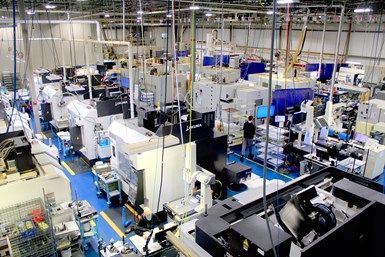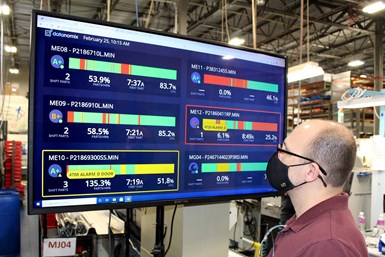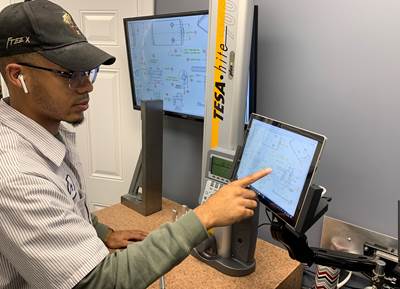Datanomix Fusion Enables EPTAM to Visualize Facility, Optimize Resources
Faced with rising customer demand for high-precision parts EPTAM Precision Plastics used Datanomix Fusion to streamline data collection, improve quote accuracy and discover training gaps.
Share









Hwacheon Machinery America, Inc.
Featured Content
View More

EPTAM Precision Plastics makes critical components for medical, aerospace and process equipment industries at precise tolerances.
EPTAM Precision provides a wide range of precision-machined parts for aerospace, medical, semiconductor and other commercial manufacturing markets. Of its three locations, its New Jersey facility produces metal parts and its Colorado facility produces injection-molded parts. New Hampshire-based EPTAM Precision Plastics division uses nearly 75 CNC machines to produce plastic parts (with some crossover to metal parts). It makes critical components for medical, aerospace and process equipment industries at precise tolerances. The parts EPTAM Precision Plastics produces range from 1 to 50 inches, and are used in a variety of applications, from orthopedic surgical kits to chemical containment units and devices used in semiconductor fabrication.
Despite having a sign permanently fixed to the front of its building reading “machinists wanted,” the company was challenged to find experienced, qualified people to fill its customers’ ever-increasing orders and forecasts over three production shifts. As a result, EPTAM decided to augment its staff with technology designed to better visualize its facility and meet the growing demand on its people by customers and suppliers. After seeing a demonstration of Datanomix’s Fusion software, EPTAM chose it to monitor, measure and identify capacity constraints. The company began by integrating the Fusion system into its medical components value stream.

EPTAM Precision Plastics medical components cell senior group leader Jesse Bunnell improved job predictability and spotted training gaps with Datanomix Fusion’s reports.
Benchmarking Production
Datanomix Fusion production monitoring software connects to the controller of each CNC machine on the production floor, reading data through industry-standard protocols like MTConnect and FANUC Focas, then determines benchmark information such as typical cycle times, utilization and rate of part production. The process is fully automatic — it does not require operator input or enterprise resource planning (ERP) data integration to understand what part is being made or how to create the benchmark. It determines targets within a handful of parts, but constantly recalibrates as it obtains more data. The software assigns a productivity score called Fusion Factor on a scale that ranges from A+ to C-: As indicate production at or above the benchmark, Bs mean production has fallen slightly behind and Cs warn of severe problems. These ratings inform most of Fusion’s other features.
For its part, EPTAM will often have a senior machinist run a new job to demonstrate peak performance — for example, to show that a particular job should make a part every 45 minutes, 30 of which are machining time and 15 of which are various operator interactions, resulting in 67% utilization and a 0.75 parts per hour rate. The software then compares regular production to this benchmark, noting when the Fusion Factor drops and examining the data for patterns. These patterns can help supervisors spot training gaps — as when an operator is taking longer at a particular step — or other efficiency or resource deviations the manufacturer can adjust for continuous improvement.
Putting Data Into Practice
The Fusion software generates benchmark and performance data into several reports, each of which streamlines a different facet of production visibility.
- The Shift Report doubles down on the process described above, summarizing the productivity of entire work cells with detailed shift comparisons of the job scores achieved at each station. Group leaders can use this report to see variances between shifts and workstations, further improving their ability to identify training gaps and performance differences to continually communicate and improve.
- Coffee Cup Reports create a scorecard at the end of the day or shift, concisely communicating the previous day or shift’s output to upper management. The Fusion system emails these reports to a configurable distribution list, providing part counts, cycle times, alarm frequency and production score by job. The report’s name comes from the idea that management will review the report at the start of the day over a cup of coffee, before presenting the information at each morning’s production meeting.
- Quote Calibration takes the production benchmarks and maps them to profitability goals on a part-number basis. Shops like EPTAM can enter a target shop rate or machine rate, which combines with the Fusion Score to show the minimum they should charge per part to sell their machining time at the desired margin. Management can use this data to foster a clear connection between business performance goals, part performance and shopfloor initiatives.

Datanomix’s Fusion system’s automated capabilities save Jesse Bunnell hours of manually collecting and organizing data.
Versatility Through Data
By automatically gathering this information and generating these reports, Datanomix says its Fusion software saved EPTAM hours of data chasing, as the shop had previously collected this data by walking the shop floor. The extra time not only enabled the shop to increase its productivity and make key decisions, it allowed EPTAM to better adjust alongside the market.
During the early part of the COVID pandemic, EPTAM’s medical division saw a decrease in demand on account of the freezing of elective surgeries, even as its semiconductor part division saw a massive increase in demand from original equipment manufacturers (OEMs). Some of these semiconductor parts use expensive materials that range from $50 to $400 per pound and require material stability in extreme temperatures and corrosive environments, as well as antibacterial and dimensional integrity. As a result, manufacturing these parts requires EPTAM to stay cognizant of overwhelming amounts of data. The parts’ cycle times also tend to extend into hours, making utilization of machine-time and conformance to cycle time standards vital. Having seen the benefits of machine-level benchmarks and increased visibility from its medical components cell, EPTAM quickly decided to connect its semiconductor fabrication machines to Datanomix’s Fusion system.
With the EPTAM Northfield facility now connected and able to visualize data, the production staff has complete clarity on the performance of the day while it happens, on how to turn threats to productivity into training and continuous improvement, on obstacles standing in the way of greater output and on where to dispatch key personnel to keep the day trending positively.
Related Content
How this Job Shop Grew Capacity Without Expanding Footprint
This shop relies on digital solutions to grow their manufacturing business. With this approach, W.A. Pfeiffer has achieved seamless end-to-end connectivity, shorter lead times and increased throughput.
Read MoreGenerating a Digital Twin in the CNC
New control technology captures critical data about a machining process and uses it to create a 3D graphical representation of the finished workpiece. This new type of digital twin helps relate machining results to machine performance, leading to better decisions on the shop floor.
Read MoreTips for Designing CNC Programs That Help Operators
The way a G-code program is formatted directly affects the productivity of the CNC people who use them. Design CNC programs that make CNC setup people and operators’ jobs easier.
Read MoreAutomated CAM Programming – Is Your Software Really Delivering?
A look at the latest automation tools in Autodesk Fusion 360 software and how forward-thinking machine shops and manufacturing departments are using them to slash delivery times and win more business.
Read MoreRead Next
Datanomix Fusion Maximizes J&W Swiss Machine's Efficiency
Datanomix’s Fusion software led J&W Swiss Machine to a 13% increase in cycle-time conformance and a 1.5 day improvement on its on-time delivery.
Read More11th Annual Top Shops Benchmarking Program Opens with New Features
For 2021, Modern Machine Shop’s Top Shops, the annual benchmarking program for CNC machine shops, is open year-round and includes a new sourcing platform.
Read More"Soft" Automation is Long Overdue
Digitalizing and systemizing the clerical work of quoting and quality control is more achievable and more urgent than ever.
Read More



















































